Understanding a Hidden Emotional Challenge
Alexithymia is a subtle yet impactful personality trait characterized by difficulty in recognizing, processing, and expressing one’s own emotions. Despite not being classified as a mental disorder, it significantly influences emotional well-being and social functioning. This comprehensive overview explores the causes, symptoms, diagnosis methods, and treatment options related to alexithymia, offering a thorough understanding of this complex condition.
Defining and Characterizing Alexithymia
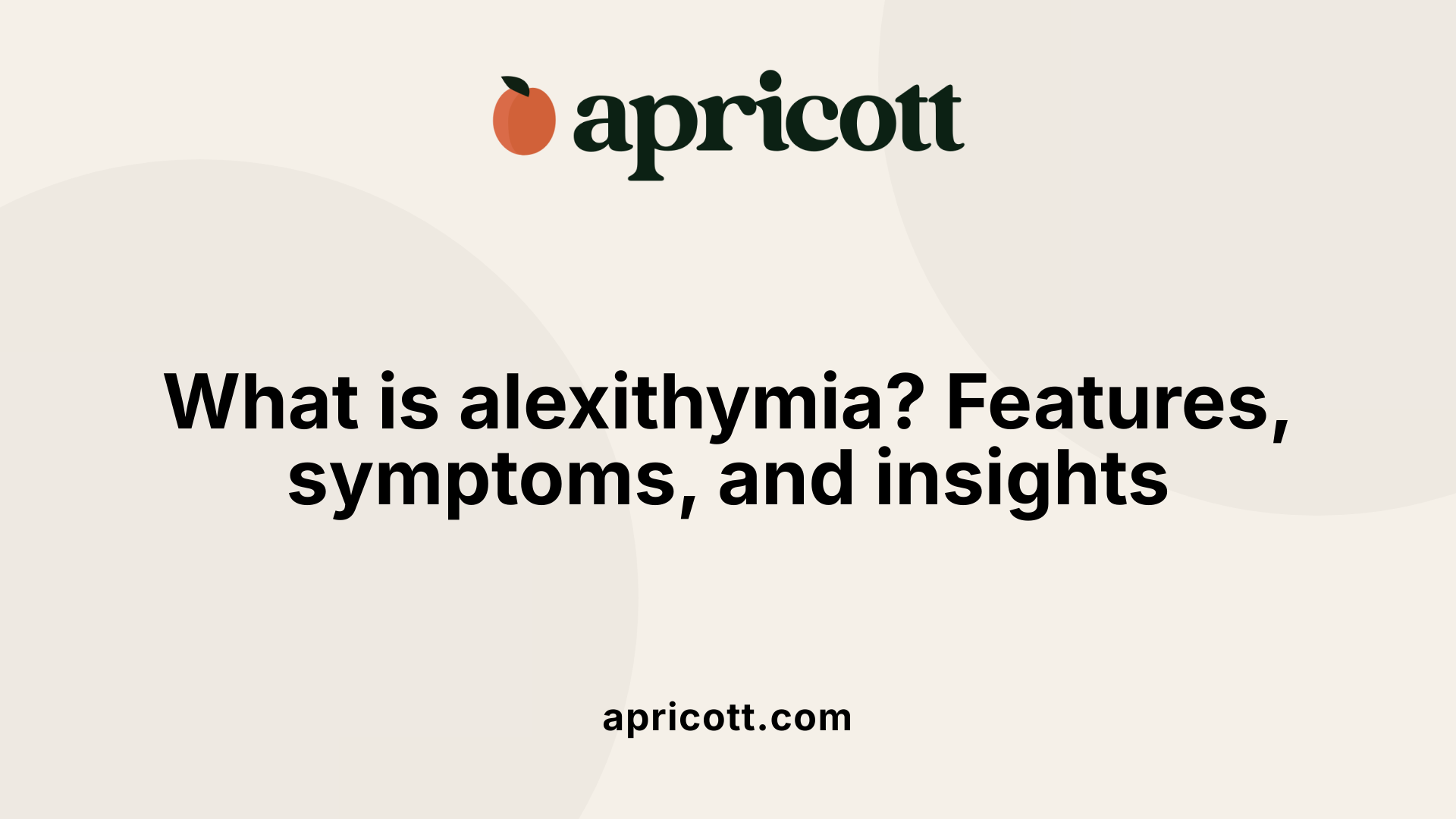
What is alexithymia and how is it characterized?
Alexithymia is primarily considered a personality trait marked by challenges in recognizing, describing, and understanding one's own emotions. People with this condition often find it difficult to put feelings into words and may instead describe their emotional experiences in objective, factual, or physiological terms. For instance, rather than articulating feeling sad, they might report physical sensations like tension or fatigue.
A distinctive feature of alexithymia is an externally oriented thinking style. Individuals tend to focus on external events rather than internal emotional states, which can make emotional regulation and social interaction difficult.
Common symptoms include trouble identifying feelings, distinguishing between emotions and bodily sensations, and expressing feelings verbally. Some people report physical symptoms such as headaches, fatigue, or tension without clear emotional reasons.
Alexithymia is often linked with various psychological and neurodevelopmental conditions, such as autism spectrum disorder, depression, post-traumatic stress disorder (PTSD), and somatoform disorders. It is estimated that about 10% of the general population exhibits significant levels that impair social and emotional functioning.
Assessment of alexithymia typically involves self-report tools, with the Toronto Alexithymia Scale (TAS-20) being the most widely used. Higher scores on this scale indicate greater difficulty in emotional awareness.
While not formally classified as a mental disorder in diagnostic manuals like the DSM-5, alexithymia greatly influences emotional well-being and social relationships. Treatment efforts generally focus on psychotherapy, aiming to enhance emotional literacy, recognition, and expression, which can improve overall mental health and quality of life.
| Feature | Description | Additional Information |
|---|---|---|
| Main characteristic | Difficulty in recognizing, describing, and understanding emotions | Assessed via TAS-20 or similar tools |
| Style of thinking | Externally oriented | Focus on facts vs. feelings |
| Common symptoms | Somatic complaints, emotional numbness | Physical sensations often reported |
| Prevalence | About 10% in the general population | Higher in certain disorders |
| Associated conditions | Autism, depression, PTSD, somatoform disorders | Affects social and emotional functioning |
| Treatment focus | Improving emotional awareness and regulation | Includes psychotherapy and emotional skills training |
Significant Symptoms and Manifestations
What are the typical symptoms and signs of alexithymia?
People with alexithymia often exhibit a range of signs that reflect their difficulty in processing and expressing emotions. The most noticeable symptom is trouble recognizing, identifying, and describing their own feelings. They may find it challenging to articulate what they are experiencing emotionally, often describing feelings in factual or external terms rather than emotional language.
A common physical manifestation includes somatic complaints such as headaches, fatigue, muscle tension, or unexplained pain. These symptoms often occur without an apparent medical cause but are linked to their difficulty in emotional awareness. Individuals might report feeling physically tense or fatigued, which they cannot easily connect to emotional stress.
In social settings, these individuals tend to struggle with reading facial expressions, tone of voice, or other social cues that indicate emotional states in others. They might seem distant, unresponsive, or appear indifferent, which can affect their relationships negatively.
Their impact on daily functioning is significant. Many experience discomfort in social situations, find it hard to empathize with others, and often have trouble maintaining close relationships. Their limited emotional vocabulary and rigid thinking styles can hinder effective communication and conflict resolution.
Overall, individuals with alexithymia may appear emotionally unresponsive or flat, yet they often experience internal distress, such as feelings of emptiness or frustration, which they find difficult to express or understand. These symptoms can contribute to feelings of social alienation and may exacerbate existing mental health issues like depression or anxiety.
Underlying Causes and Risk Factors
What are the common causes or risk factors associated with alexithymia?
Alexithymia results from a complex interplay of genetic, neurological, and environmental influences. Research suggests a genetic predisposition, which is supported by observations of higher prevalence rates among individuals with neurodevelopmental disorders such as autism spectrum disorder. This indicates that hereditary factors may contribute to differences in brain structures involved in emotional processing.
Neurological factors are central to understanding alexithymia. Abnormalities or damage in key brain regions like the anterior insula, amygdala, and parts of the frontal lobes have been linked to difficulties in recognizing and expressing emotions. The insula, especially, plays a crucial role in interoception—the perception of internal body sensations—and deficits here can impair emotional awareness.
Environmental factors significantly influence the development of alexithymia. Childhood trauma, including neglect and abuse, can lead to lasting changes in brain structures responsible for emotional regulation. Such adverse experiences may cause or exacerbate difficulties in understanding and communicating feelings later in life.
Beyond trauma, aspects like low socioeconomic status, limited access to education, poor social support, and significant stressors—such as war, illness, or loss—are associated with increased risk. These factors can disrupt emotional development and lead to the behavioral and neural patterns characteristic of alexithymia.
Furthermore, it is often linked to a range of mental health conditions. Depression, anxiety, PTSD, and other psychiatric disorders are frequently associated with alexithymia, either as co-occurring traits or consequences of brain dysfunctions. For instance, damage from neurological diseases such as Parkinson’s or stroke can also induce or worsen symptoms.
In summary, the causes of alexithymia are multifaceted, involving genetic predispositions, structural and functional brain abnormalities, and psychosocial factors. Recognizing these helps in understanding its development and guiding tailored interventions.
Diagnostic Processes and Tools
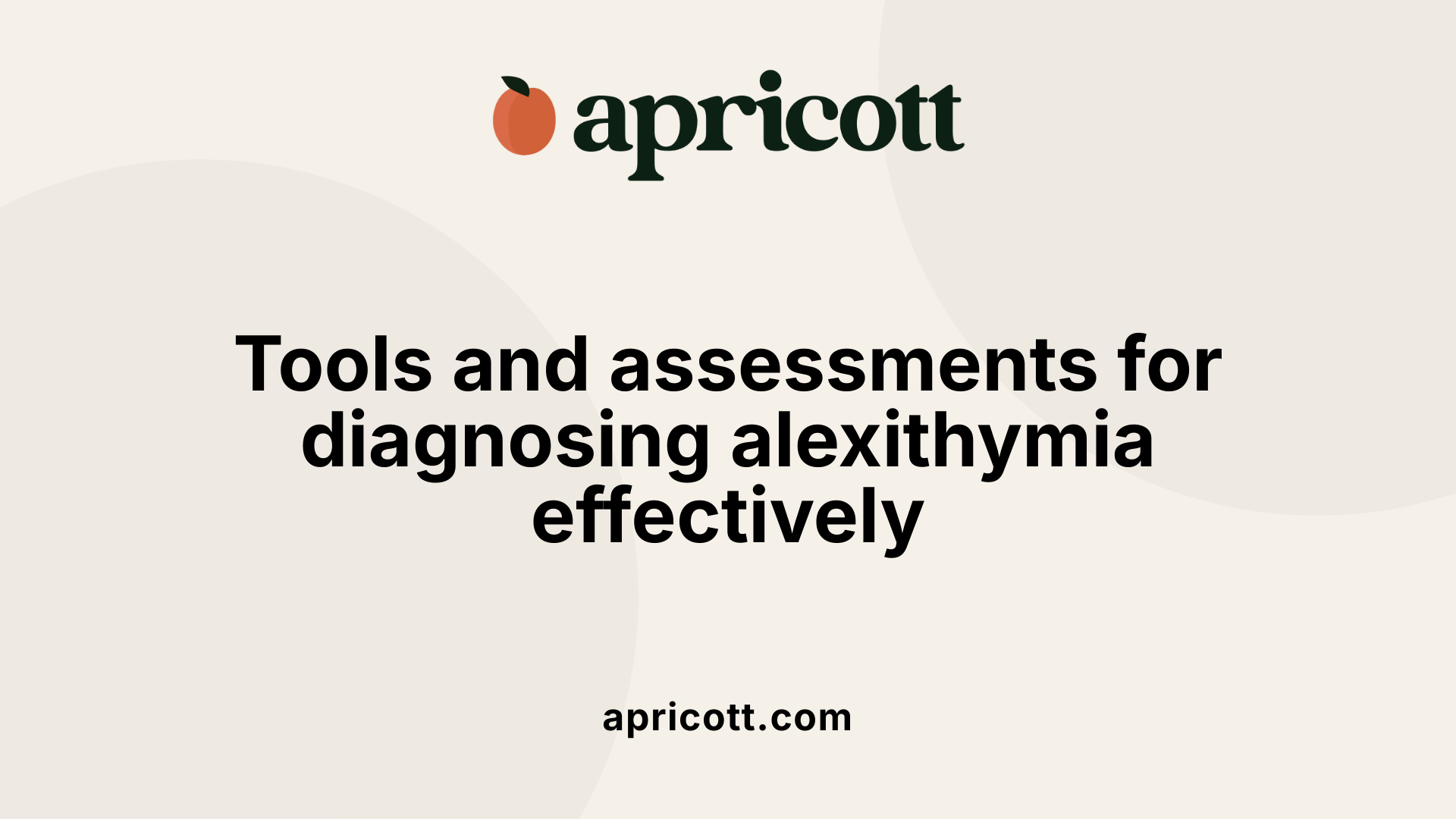
How is alexithymia diagnosed?
Diagnosing alexithymia involves a multifaceted approach that combines clinical expertise with various assessment tools. Since no definitive biological test or marker exists, mental health professionals rely heavily on a blend of questionnaires, interviews, and sometimes neuroimaging to arrive at a diagnosis.
One of the most common screening instruments is the Toronto Alexithymia Scale (TAS-20). This self-report questionnaire helps evaluate difficulties individuals have with recognizing, describing, and focusing on their feelings. It measures three main aspects: difficulty identifying feelings, difficulty describing feelings, and a tendency toward externally-oriented thinking. The TAS-20 has been widely validated and is frequently used in both research and clinical practice.
Alongside self-report tools, structured clinical interviews provide more nuanced insights. The Toronto Structured Interview for Alexithymia (TSIA) is designed to probe deeper into emotional awareness and expression. It allows clinicians to observe how individuals articulate their feelings and interpret their emotional experiences.
Collateral reports from family members, partners, or close friends can also help. These sources can provide valuable external perspectives on the person’s emotional expression and social interactions that might not be fully captured through self-assessment alone.
In some cases, neuroimaging techniques such as MRI scans are used to identify structural or functional abnormalities in brain regions involved in emotion processing, like the insula, anterior cingulate cortex, or prefrontal areas. While not routine, neuroimaging can supplement assessments, especially in cases where neurological damage or brain injury is suspected.
Additional tools include projective tests like the Levels of Emotional Awareness Scale (LEAS), which assess how individuals perceive and articulate emotions in response to different scenarios. Newer questionnaires, such as the Observer Alexithymia Scale (OAS) and the Overlap of Anxiety and Alexithymia Questionnaire (OAQ-G2), further aid in capturing the multidimensional nature of the condition.
Overall, diagnosis of alexithymia is a comprehensive process that integrates patient self-reports, clinical observations, collateral information, and, when relevant, neurobiological data. The goal is to obtain a reliable picture of emotional awareness and regulation, helping to guide effective interventions and support strategies.
Treatment Strategies and Therapeutic Approaches
What treatment options are available for managing alexithymia?
Managing alexithymia involves various therapeutic techniques designed to improve emotional awareness, recognition, and expression. Since alexithymia is not classified as a mental disorder but rather a personality trait or construct, there are no standardized medication treatments specifically for it. Instead, therapies focus on developing emotional literacy and regulatory skills.
Cognitive-behavioral therapy (CBT) is one of the most supported approaches. It helps individuals identify and challenge their thoughts about emotions and encourages practices like mindfulness and emotional tracking. Acceptance and Commitment Therapy (ACT) can also be beneficial by promoting acceptance of emotional experiences and enhancing psychological flexibility.
Emotion-focused therapy aims to increase emotional awareness and processing, helping individuals to understand the connection between their feelings and thoughts. Psychodynamic therapy offers insight into unconscious patterns that may contribute to difficulties in processing emotions, often related to early experiences or trauma.
Supportive therapies such as interpersonal therapy focus on improving social skills and improving communication in relationships, which are often affected by alexithymia.
In addition to talk therapies, mindfulness practices and emotional skills training can be effective. Techniques like body awareness exercises, guided imagery, color descriptions, and using rating scales for feelings help individuals become more attuned to internal sensations linked to emotions.
Expressive therapies—including art, music, dance, and writing—allow for alternative channels of emotional expression. These modalities help individuals explore and express feelings in non-verbal ways, which can be especially beneficial in reducing emotional suppression.
Addressing co-occurring conditions is also important. When anxiety, depression, or other mental health issues are present, medications such as antidepressants or anti-anxiety drugs may be prescribed to support overall treatment goals.
Supporting emotional awareness and regulation through psychoeducation allows individuals to understand the importance of recognizing and managing feelings. Family or group therapy settings can provide additional social support and modeling of emotional language.
Overall, treatment should be tailored to each individual’s needs, often combining several approaches to enhance emotional functioning and quality of life.
The Interconnection with Mental and Physical Health Conditions
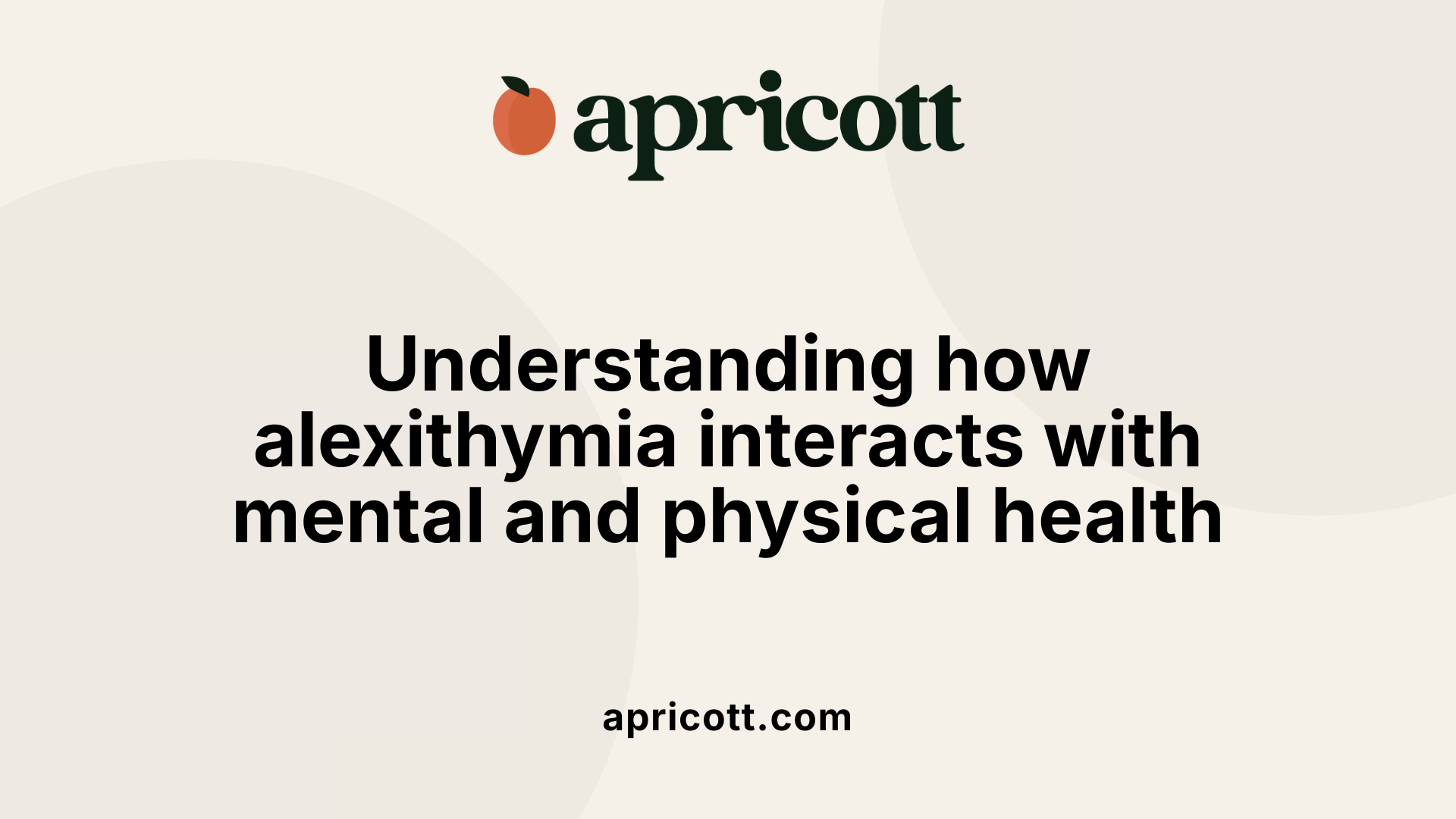
What is the relationship between alexithymia and other mental health or physical conditions?
Alexithymia is closely linked to a variety of mental health issues, including depression, anxiety, post-traumatic stress disorder (PTSD), eating disorders, and schizophrenia. Many individuals with these conditions also display traits of alexithymia, which can worsen emotional regulation difficulties and complicate treatment efforts.
This condition is also prevalent among people with autism spectrum disorder (ASD), with about half experiencing significant alexithymia. Such overlap affects social functioning and empathy, making emotional connections and understanding others more challenging.
In addition to mental health conditions, alexithymia influences physical health. It has been associated with immune system dysregulation, heightened physiological arousal, and increased reporting of somatic symptoms like pain and fatigue. Many individuals with alexithymia frequently visit healthcare providers due to persistent physical complaints, often without clear medical explanations.
Neurobiological research suggests that alexithymia involves structural and functional abnormalities in brain regions responsible for emotional awareness, such as the insula and prefrontal cortex. These deficits can interfere with autonomic and immune responses, leading to higher stress levels and inflammation.
Furthermore, alexithymia may contribute to maladaptive behaviors like substance abuse, compulsive gambling, and self-harm, potentially as coping mechanisms for unprocessed emotions.
Assessment tools like the Toronto Alexithymia Scale help identify emotional processing deficits. Targeted therapies focusing on emotional awareness, regulation, and interpersonal skills can improve both mental and physical health outcomes.
| Aspect | Description | Implications |
|---|---|---|
| Associated Mental Conditions | Depression, anxiety, PTSD, eating disorders, schizophrenia | Poorer treatment responses, emotional dysregulation |
| Physical Health Links | Immune dysfunction, somatic symptom reporting, chronic pain | Higher healthcare utilization, chronic health issues |
| Neural Basis | Abnormalities in insula, prefrontal cortex, and interoception circuits | Affects emotional awareness and immune regulation |
| Behavioral Consequences | Substance use, compulsive behaviors, social withdrawal | Increased health risks, decreased quality of life |
Understanding the connections between alexithymia and health conditions emphasizes the importance of comprehensive assessment and intervention. Addressing emotional processing deficits can lead to better management of co-occurring mental health issues and improve overall well-being.
Cutting-Edge Scientific Research and Advances
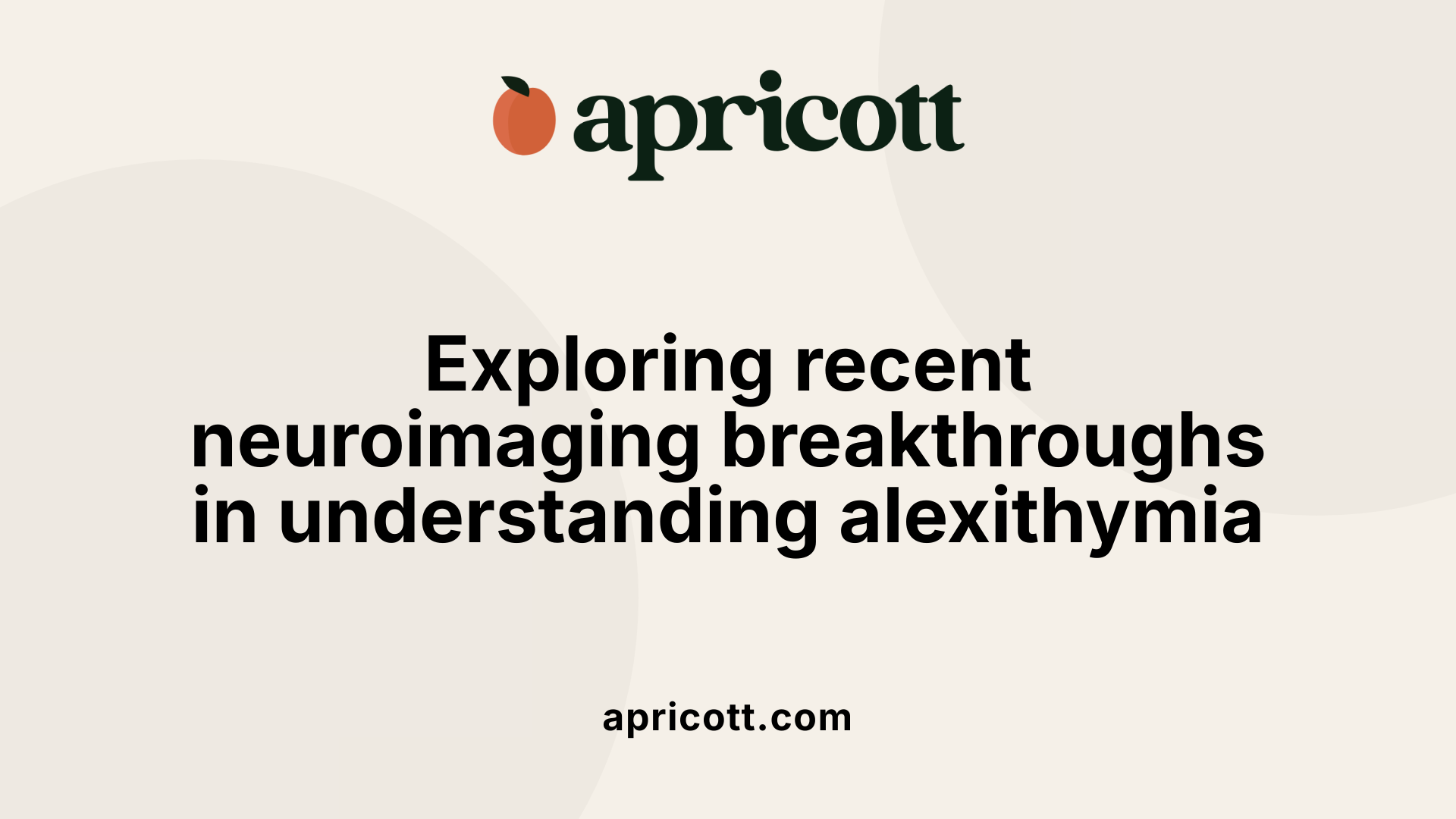 Recent scientific research is delving deep into the neurobiological foundations of alexithymia, especially focusing on how specific brain regions contribute to emotional recognition and regulation. Neuroimaging techniques such as functional magnetic resonance imaging (fMRI) and structural MRI have been instrumental in uncovering the brain's role in this condition.
Recent scientific research is delving deep into the neurobiological foundations of alexithymia, especially focusing on how specific brain regions contribute to emotional recognition and regulation. Neuroimaging techniques such as functional magnetic resonance imaging (fMRI) and structural MRI have been instrumental in uncovering the brain's role in this condition.
Key areas of interest include the insula, anterior cingulate cortex, amygdala, and prefrontal cortex. These regions are critical for processing emotional information, integrating bodily sensations, and regulating emotional responses. For instance, studies consistently show that individuals with alexithymia often exhibit reduced activity or structural abnormalities in the anterior insula, which is pivotal in interoception—the perception of internal bodily states linked to emotions.
Furthermore, research indicates that the connectivity between these regions, especially between the prefrontal cortex and limbic structures like the amygdala, may be disrupted in alexithymic individuals. This disconnection can impair emotional awareness and expression, contributing to the characteristic difficulties in recognizing and verbalizing feelings.
By examining these neural circuits, scientists aim to understand how deficits in emotion processing are rooted in brain dysfunctions. Such insights are helping move toward developing targeted interventions that can modify neural activity and improve emotional skills.
Overall, ongoing investigations are painting a detailed picture of the neural signatures associated with alexithymia, paving the way for more personalized treatment approaches and better management of related mental health conditions.
Supporting Individuals and Communities
How can supporting someone with alexithymia make a difference?
Providing support to individuals with alexithymia can significantly improve their emotional well-being and interpersonal relationships. Patience and consistent communication are essential, as these individuals often struggle to recognize or express their feelings.
Modeling emotional language and encouraging professional help can foster better emotional awareness. Educating family, friends, and caregivers about the nature of alexithymia helps them understand that it’s not a lack of caring but a challenge in processing emotions. This understanding nurtures empathy and reduces frustration.
Mental health professionals often use structured therapies such as cognitive-behavioral therapy (CBT), dialectical behavior therapy (DBT), and mindfulness training. These approaches aim to enhance emotional recognition, labeling, and regulation skills.
Support groups and psychoeducational programs offer valuable resources, providing coping strategies, social connections, and shared experiences.
Promoting empathy and creating a nonjudgmental environment encourages individuals to explore their feelings safely. Continuous learning about emotional processing can help them develop better interpersonal skills.
Ultimately, such support can lead to improved mental health, healthier relationships, and a greater sense of self-awareness, leading to a more fulfilling life for those with alexithymia.
| Role of Support | How It Helps | Additional Strategies |
|---|---|---|
| Family and friends | Foster understanding, patience, and empathy | Provide education about alexithymia; practice active listening |
| Clinicians | Implement tailored therapies like CBT, mindfulness | Use structured techniques such as emotional vocabulary exercises |
| Community resources | Offer peer support and psychoeducation | Join support groups; participate in psychoeducational programs |
Supporting someone with alexithymia is about creating a nurturing environment that emphasizes understanding and continuous learning, which can profoundly impact their emotional health and quality of life.
Summary and Essential Takeaways
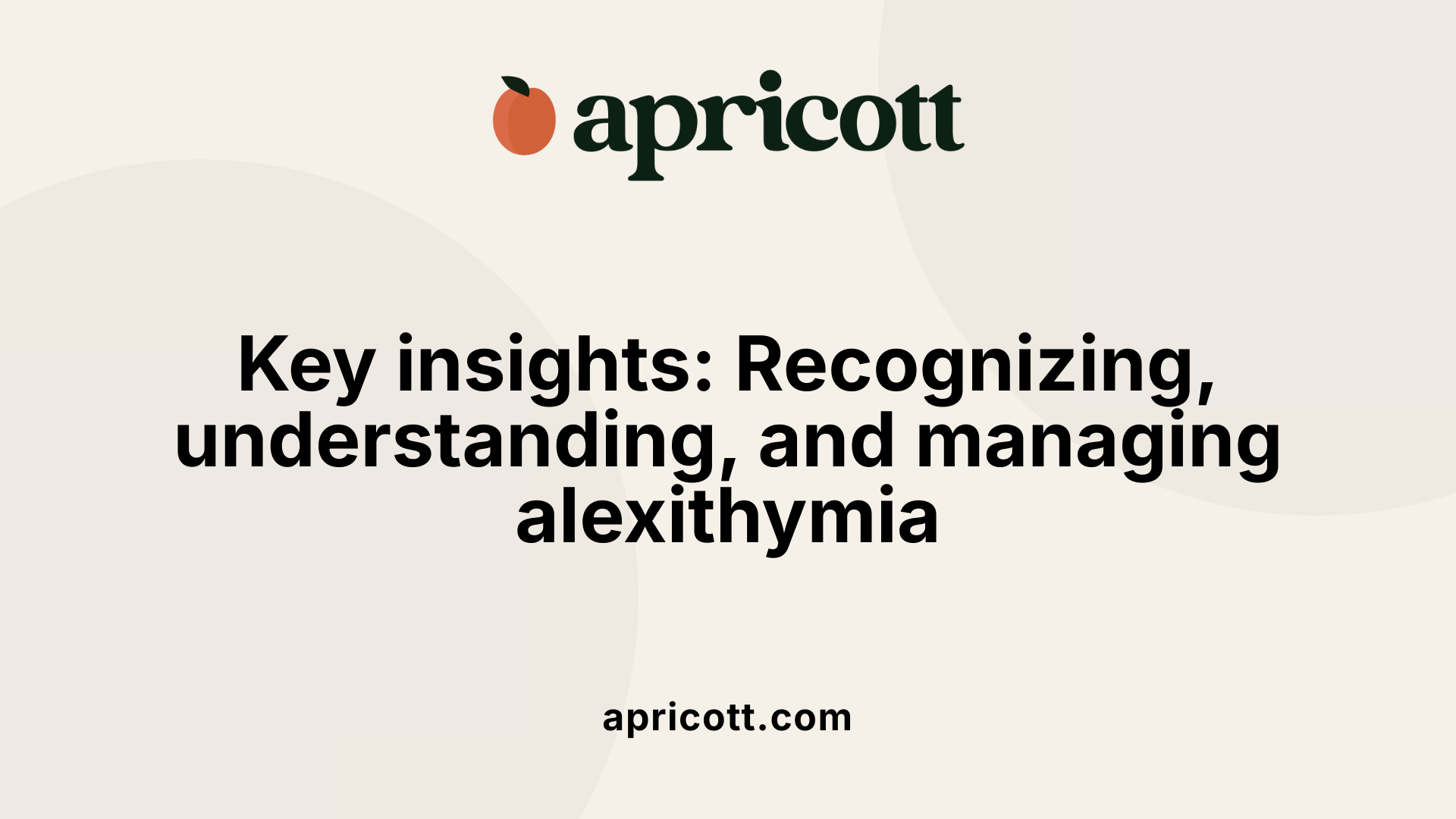
Recap of alexithymia’s definition, symptoms, causes, and treatments
Alexithymia is a personality trait characterized by difficulty recognizing, understanding, and expressing emotions. It affects approximately 10% of the population and is often linked with mental health issues like depression, anxiety, autism, PTSD, and neurological conditions such as Parkinson's disease or traumatic brain injury. Symptoms include trouble identifying feelings, describing emotions, and distinguishing between emotions and bodily sensations. Physical complaints like headaches or fatigue without apparent cause are common. Causes involve genetic predisposition, brain damage—particularly to the insula and prefrontal regions—and early trauma. Treatment primarily focuses on therapies such as cognitive behavioral therapy (CBT), dialectical behavior therapy (DBT), and mindfulness interventions aimed at enhancing emotional awareness and regulation.
Significance of early detection and intervention
Early recognition of alexithymia is crucial because it often worsens mental health conditions like depression and impairs social relationships. Using screening tools such as the Toronto Alexithymia Scale (TAS-20) helps identify individuals who may benefit from intervention. Addressing the condition early can improve emotional skills, foster better social functioning, and reduce associated psychosomatic symptoms. Since alexithymia can be stable but responsive to therapy, timely support can lead to meaningful improvements.
The importance of compassionate support and tailored therapies
Supporting someone with alexithymia involves patience, consistent communication, and modeling emotional language. Tailored therapies—like structured emotion recognition exercises, psychoeducation, and mindfulness—can help individuals develop emotional literacy. Mental health professionals emphasize understanding over fixing, guiding friends and family to adopt a compassionate approach. Recognizing that alexithymia is not a mental illness but a trait that interacts with various conditions reinforces the need for personalized interventions. Supporting efforts and encouraging professional help can significantly enhance quality of life, emotional well-being, and relationship dynamics.
Moving Forward: Embracing Compassion and Continued Research
Understanding the multifaceted nature of alexithymia highlights the importance of early detection, personalized treatment, and empathetic support. As science advances with neurobiological insights and innovative assessment tools, hope grows for more effective interventions. By fostering greater awareness and compassion, we can help individuals with alexithymia navigate their emotional landscape, leading to improved mental health and richer social connections.
References
- Alexithymia: Causes, Symptoms, and Treatments
- Alexithymia: Causes and Symptoms
- Alexithymia: What Is It, Signs, Symptoms, and More
- Alexithymia: Symptoms, diagnosis, and related conditions
- A beginner's guide to alexithymia
- Alexithymia (Emotional Blindness): Causes and Treatments
- What Is Alexithymia? Causes, Symptoms, and Ways to ...
.svg)
.svg)








